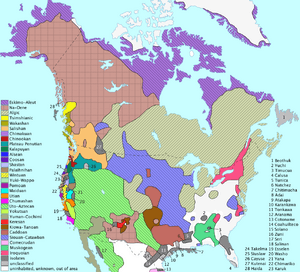Pacific Northwest languages facts for kids
The Pacific Northwest languages are the native languages spoken by Indigenous peoples in the Pacific Northwest region of North America. This area includes parts of what is now the United States and Canada. It's important to know that "Pacific Northwest languages" is a geographic term. It doesn't mean these languages are all related like members of one big family.
In fact, the Pacific Northwest is famous for having many different language families. This means there are lots of languages that seem to have developed separately. But because these languages have been spoken close to each other for thousands of years, they have influenced each other. They share many features, even if they are not related. This shared influence creates what is called a linguistic area.
Language Families of the Pacific Northwest
The main language families in this area are the Salishan, Wakashan, and Chimakuan families. These are central to the Pacific Northwest linguistic area.
Other languages also share some features. These include Tsimshianic, Chinookan, and Sahaptian languages. There is also Kutenai, which is a language isolate. A language isolate means it's a language that doesn't seem to be related to any other known language family.
Unique Sounds in Pacific Northwest Languages
These languages are known for their interesting and sometimes complex sound systems. They often have many sounds that are not found in English. For example, they have a lot of "dorsal" sounds. These are sounds made using the back of your tongue.
The Tlingit language is a good example. It has about 24 different stop and fricative sounds. Many of these are made at the back of the mouth or throat. This includes sounds made with the soft palate (velar), the uvula (uvular), or the glottis (glottal).
You might also hear sounds like "ejectives." These are sounds made by pushing air out with a popping noise from the throat. Another type is "pharyngeal" sounds. These are made by tightening muscles in the throat. These unique sounds make Pacific Northwest languages very special.


